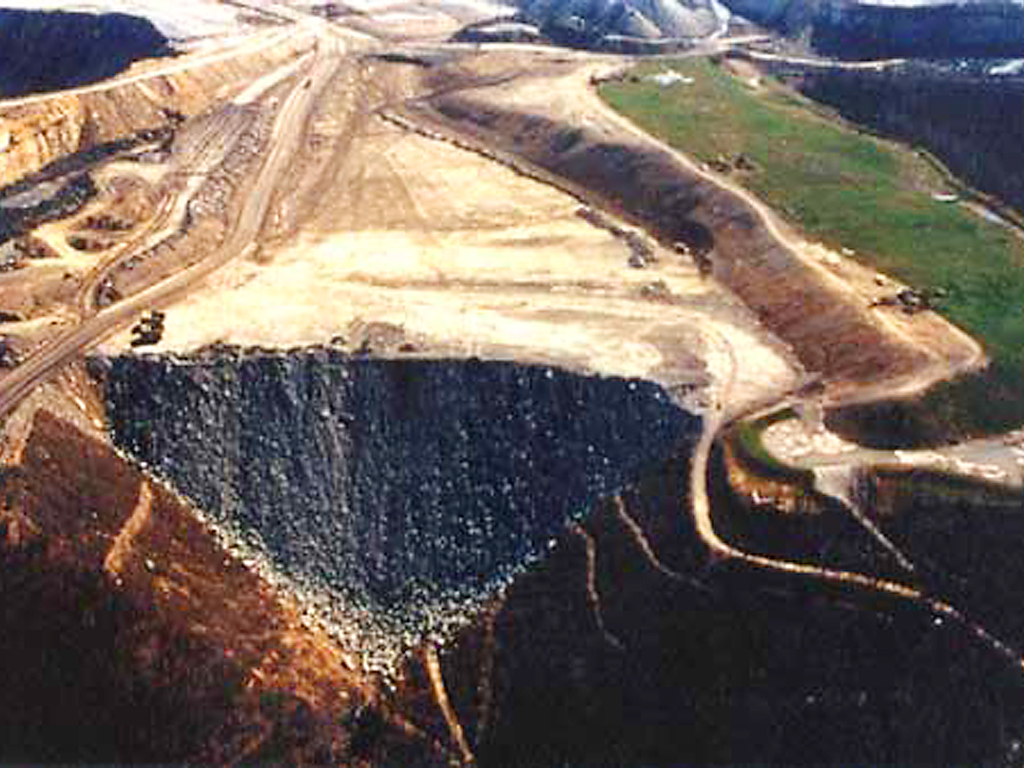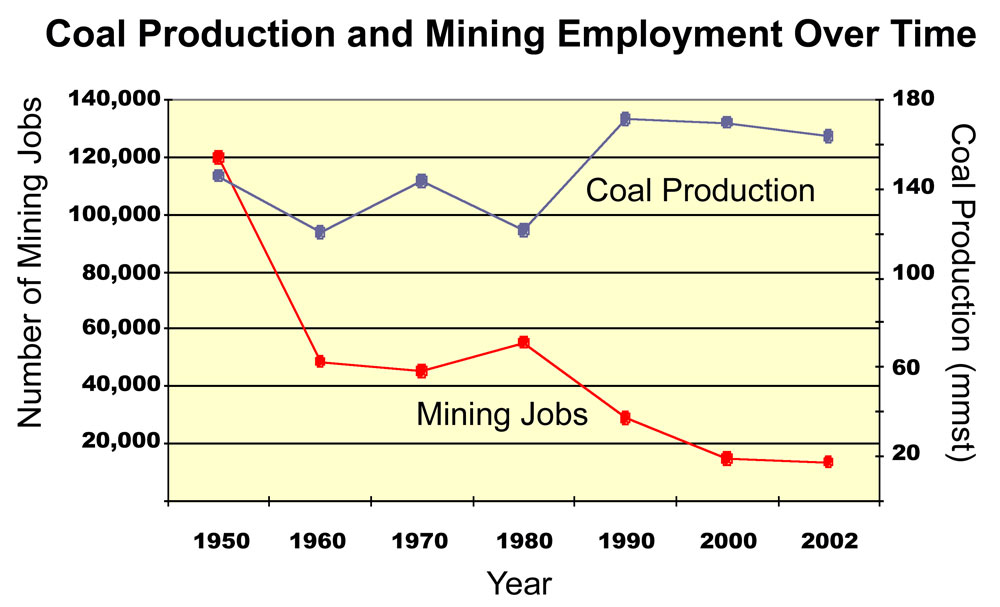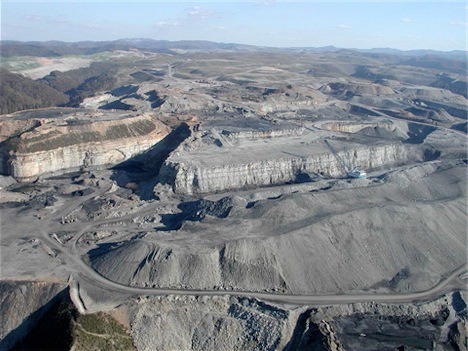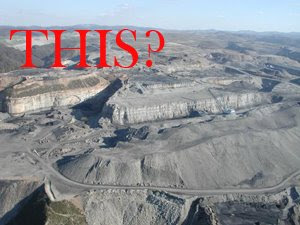If you're a reader of the Huffington Post Green Page then you are almost certainly aware that the Obama Administration signaled a major shift yesterday in how mountaintop removal coal mining will be regulated. In brief, Obama's head of the EPA, announced a decision to delay and review permits for two mountaintop removal mining operations, an action that calls into question more than 100 additional valley fill permits now pending that threaten to bury hundreds more miles of headwater streams and destroy dozens more Appalachian Mountains.
In making this decision, President Obama also took another step in fulfilling his campaign promise to bring science back to it's rightful place in guiding the decisions of federal agencies. Over the course of eight years, the Bush Administration ignored the advice and analysis of the best scientists and systematically re-wrote the rules to allow companies to dump mine waste indiscriminately into streams. They also sought to allow higher levels of arsenic, selenium and other toxic metals from mine runoff in drinking water.
Realizing that Bush's policies were wrong from the start, the coal industry and supporters in Congress quickly and conveniently rolled over and died.
Not.
Actually, the blow-back was immediate and fierce from the mining industry.
Here's the response of the National Mining Association:
This action, which applies to all mining-related 404 permits in the region, puts thousands of mining jobs and coal production in Appalachia at risk. While on the one hand the administration is spending billions in stimulus jobs, it is taking away the highest paying jobs in the region by delaying needed permit approvals. This is not good for jobs or for energy security.
All of this pressure appeared to elicit an immediate backpedaling by the EPA, which issued a statement last night that seemed to contradict the early media reports. Moreover, West Virginia Governor Joe Manchin quickly took to grandstanding and went straight to Washington today to talk with Administration officials about impacts on West Virginia's economy.
All of these conflicting reports have left opponents of mountaintop removal with a little whiplash, but they should not be distressed. There is no question that the EPA's move signaled a seismic shift from the Bush Administration's lax enforcement of environmental laws, and the back-pedaling doesn't change the fact that EPA is going to bring actual science back into the permitting process.
One of the most valuable aspects of all of this is that we now have a very complete picture of the coal industry's justification for why Obama should allow the destruction of the nation's oldest and most biologically diverse mountains, and the pollution of the headwaters of many eastern rivers to continue under the Bush Administration's rules. Here's their reasoning:
14,000 mining jobs are at risk.
The savvy Huffington Post reader will probably be thinking: "14,000 jobs? Didn't the auto industry just layoff 100,000 employees? You're telling me that we are turning the oldest mountains in America into a parking lot for the sake of 14,000 jobs?"
On the surface, this would certainly be a justifiable reaction. The numbers are miniscule compared to the total number of jobs in the region and the numbers we've been hearing about mass layoffs across the country over the past 6 months. According to a report from the Bureau of Labor Statistics,
Employers took 2,769 mass layoff actions in February that resulted in the separation of 295,477 workers, seasonally adjusted, as measured by new filings for unemployment insurance benefits.
But this misses a number of important points. In defense of the mining industry, 14,000 fairly high paying jobs mean a lot in this region, which is among the poorest in the country and already suffers rampant unemployment.
But the most important point is that no jobs are being lost right away as a result of the EPA's decision. Anyone who says otherwise is posturing or bluffing.
All the EPA's announcement means is that they will temporarily maintain the status quo that has been in place since March of 2007 when a federal district court judge suspended the permitting of most valley fills until the lax Bush Administration enforcement and evaluation standards were improved. There is not a single mine that will be shut down as a result of the EPA's decision.
Presumably, mountaintop removal enthusiasts are really more concerned that new mountaintop removal mines will not come online as older mines reach the limits of their economically productive capacity and shut down. That is certainly what the author of this post would like to see happen, which may or may not make it a legitimate concern from the coal industry perspective, but it certainly changes the discussion dramatically in terms of impacts on the local economy.
To be precise, if the EPA cracks down on mountaintop removal permitting what we're talking about is phasing out some proportion of 14,000 strip mining jobs in Appalachia over the next decade. But is this a significant number? Significant enough to justify what Vanity Fair has called "the greatest act of physical destruction this country has ever wreaked upon itself?"
As an exercise - the EPA is not clear on how far they will go in reining in mountaintop removal - let's look at what might happen if the EPA completely eliminated all forms of surface mining, including mountaintop removal, in Appalachia over the next decade. I have created a number of PDF summaries of studies and reports on this subject that can be downloaded individually for those who want more detail, but here's a quick synopsis.
1. The only study that directly addresses the question of how restricting valley fill permits would affect the economy was conducted by a well-respected coal industry consulting group called Hill & Associates (H&A) in 2001. According to the study, restricting valley fills to watersheds no larger than 35 acres in size (basically cutting the amount of mountaintop removal mining in half) would decrease overall coal production by about 15% in Central Appalachia. This reflects a 65% decrease in mountaintop removal with a 10% compensatory increase in underground mining.
The employment impact of this change would be 1,345 jobs. Here's a graph showing the difference between a baseline projection and a projection based on restricting valley fills to less than 35 acres (again, meaning mountaintop removal coal production would be reduced by about 65%):
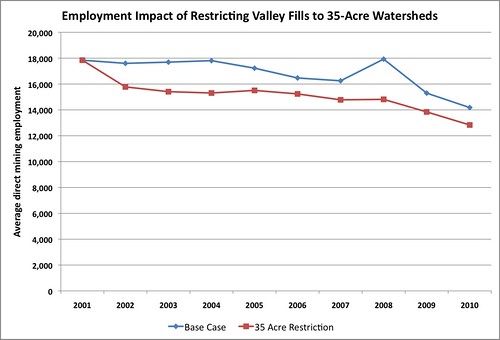
Another important point made by the H&A study is that even if no restrictions on permitting were put in place, both production and employment were projected to decline by 20-25% anyway because the most of the high-quality, easy to get coal is already mined out. Here's a quote from the study:
"... the general downward trend of total tonnage from the study region under all cases is a result we see across many modeling projects.. [it]is exacerbated toward the end of the 10-year study period by the fact that significant blocks of higher-quality Central Appalachian reserves are starting to be exhausted. The better-quality coals in this region are slowly but surely being mined out."
A final fascinating aspect of this study was that it also looked at how restricting mountaintop removal would affect the electric rates of consumers that rely on this coal for electricity. The impact would be somewhat less than 1% on electric bills.
Let me repeat: reducing mountaintop removal by 65% would lead to a wholesale electric rate increase of less than 1% in states relying on this coal and an increase in residential electric rates even smaller than that.
Here is my summary of the H&A study
And here is the original study
2. According to several coal industry insider publications, the decline in coal demand resulting from the recession is likely to lead to many more underground mines being idled. According to the February 16th edition of the Coal & Energy Price Report:
Given the weak economy and downward pressure on coal prices, in general, the table suddenly has tilted in such a way that more underground mines will be in danger of falling off the cliff. Deep mine operators who have been reluctant to idle mines in the face of a potential forced shut- down of surface jobs might re-think their hesitation.
Given that underground mines employ 1.5 times as many miners per ton produced as surface mines do, this almost certainly means that EPA's action will actually protect jobs in the short term. But other industry reports show why relying on more mining jobs is a poor response to the economic crisis anyway. Here's a quote from the March 23rd edition of the U.S. Coal Review:
Most large producers have already announced sizeable trimming efforts, and reductions by smaller operators, while more difficult to estimate, are no doubt taking place. But in the current market environment in which demand is seriously slumping, the cutbacks are expected to continue in fairly big numbers.
Here is a link to some more excerpts of recent coal industry news
3. According to a 2005 report from the Appalachian Regional Commission, employment in the mining industry is one of the best predictors of poverty and other elements of "economic distress" in Central Appalachia. Here's an excerpt from the study:
"Of all the regions in this analysis, Central Appalachia has been one of the poorest performers in relation to the ARC's economic distress measure over time. Furthermore, and unlike all other regions in the U.S., current and persistent economic distress within the Central Appalachian Region has been associated with employment in the mining industry, particularly coal mining."
But people in Appalachia have long known that it's more than just "coal mining" that's the problem and that mountaintop removal specifically destroys far more jobs than it creates. If mountaintop removal created prosperity it should have done so decades ago. Instead, the counties where mountaintop removal occurs are among the poorest in the nation, with high unemployment rates and rapidly dwindling populations. The stark reality is that few industries want to follow mountaintop removal. After all, what entrepreneur wants to open a new business in a community where massive blasts are cracking the foundations of people's homes, where hundred-year floods are an annual affair, and where the tap water looks like tomato soup and smells like rotten eggs?
This map, produced by Appalachian Voices, shows the dramatic correlation between mountaintop removal and poverty rates in Central Appalachia:
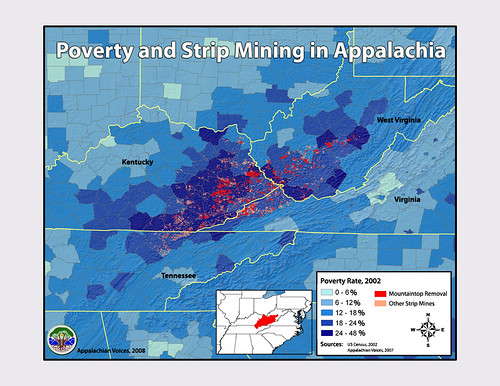
This ARC study also offered an excellent roadmap for Central Appalachian coal counties looking to improve their economic conditions:
"The counties that have emerged from distress in the region have consistently had fewer jobs in mining and a greater number of jobs in manufacturing when compared to the counties that have remained persistently distressed." The study also said:
"...regional economic development is most likely to take place when national policies create the conditions to support it. As such, addressing persistent distress would seem to require a renewed national commitment, similar to the one that inspired the establishment of the ARC and the regional development policies of the 1960s."
Sounds like President Obama is already on the right track with his green jobs and economic stimulus plans (unlike the coal state politicians that have a remarkably single-minded focus on an industry that supplies less than 2% of the jobs, but a much higher proportion of campaign contributions).
Here is a link to some more excerpts from the 2005 ARC report
That sums up the first part of the argument why President Obama should ignore the sky-is-falling predictions, disingenuous arguments and plain, old-fashioned rigged numbers that the coal industry and their supporters are throwing at him. The subject of a later post will be all of the opportunities there are and initiatives already underway in Central Appalachia to create new green jobs and diversify the economy beyond such a heavy reliance on coal.
As a preview, here's a link to another recent study by the Appalachian Regional Commission that came out just a few weeks ago. According to the story by Ken Ward at the Charleston Gazette:
An estimated 15,000 jobs per year for the next five years could be created, for a total of 60,000 new jobs, the study said. Annual energy bill savings would be almost $800 million, with that amount rising to more than $27 billion per year by 2030, the study concluded.
Now there's some job numbers that might really start getting out of the economic doldrums.
More tomorrow...
 I spoke about climate policy and politics on a half hour radio segment that aired March 27th on KPFA radio in the Bay Area. I joined Clear Air Watch's Frank O'Donnell to discuss the hard realities of climate politics and outline a policy strategy to make clean energy cheap that can overcome these realities.
I spoke about climate policy and politics on a half hour radio segment that aired March 27th on KPFA radio in the Bay Area. I joined Clear Air Watch's Frank O'Donnell to discuss the hard realities of climate politics and outline a policy strategy to make clean energy cheap that can overcome these realities. 
